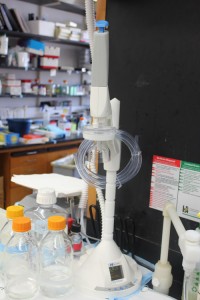El TREM2 tiene que ver con las respuestas inmunitarias e inflamatorias, y podría ser otra clave del misterio sobre las causas de la enfermedad de Alzheimer, así como un objetivo para el tratamiento, añadieron los investigadores.
"Hallamos una mutación que confiere un gran riesgo de enfermedad de Alzheimer", apuntó el investigador líder, el Dr. Kari Stefansson, director ejecutivo de deCODE Genetics, con sede en Reikiavik, Islandia.
Aunque apenas un 1.2 por ciento de la población porta la mutación TREM2, cuando se comparó a adultos de 85 o más años de edad con y sin la mutación, los que la portaban tenían casi siete veces más probabilidades de sufrir de enfermedad de Alzheimer, señaló.
Por supuesto, portar esta mutación no significa que la persona esté destinada a desarrollar enfermedad de Alzheimer. El Alzheimer es una enfermedad compleja, y una persona probablemente necesite que se combinen varios factores de riesgo para producir la afección, señaló Stefansson.
"Esto tiene implicaciones para el tratamiento", afirmó. La mutación podría ser un objetivo para nuevos fármacos que suavice su efecto, afirmó.
El informe aparece en la edición en línea del 14 de noviembre de la revista New England Journal of Medicine.
Un experto en Alzheimer elogia el nuevo estudio.
"Esto muestra el valor de la investigación básica", aseguró William Thies, director médico y científico de la Asociación del Alzheimer (Alzheimer's Association). "Este tipo de ciencia es muy importante, y puede acelerar el hallazgo de mejores terapias para la enfermedad de Alzheimer".
Thies anotó que este hallazgo no significa que las personas deban correr a hacerse pruebas de la mutación. En un futuro, la mutación podría ser importante para los tratamientos, pero todavía falta mucho, planteó.
La necesidad de desarrollar tratamientos para el Alzheimer es un tema urgente, añadió.
"El imperativo de hallar nuevas terapias es obvio", enfatizó Thies. "Los datos demográficos sugieren que para mediados de este siglo habrá 15 o 16 millones de personas con la enfermedad, y no podemos cuidar a tanta gente. El trastorno en la sociedad será grave".
Para el estudio, el grupo de Stefansson obtuvo secuencias genéticas de más de 2,200 islandeses. Los investigadores buscaron variantes genéticas entre los que sufrían Alzheimer y los que no.
Para comprobar sus resultados, los investigadores observaron otras poblaciones en Estados Unidos, Noruega, los Países Bajos y Alemania, donde confirmaron los hallazgos.
Otro experto anotó que el hallazgo sobre la inflamación es importante.
"Es de conocimiento común que la inflamación es parte de la patogénesis del Alzheimer", señaló el Dr. Sam Gandy, director asociado del Centro de Investigación sobre la Enfermedad de Alzheimer Mount Sinai, en la ciudad de Nueva York.
Lo que este estudio muestra es que la inflamación es tan importante que un desequilibrio del componente inflamatorio puede afectar el riesgo de la enfermedad, comentó.
"Actualmente no contamos con un nuevo fármaco, pero el TREM2 resalta pasos en la patogénesis del Alzheimer potencialmente susceptibles a los medicamentos que quizás nunca hubiéramos estudiado a no ser por esta información genética", planteó Gandy.
Greg Cole, otro experto y neurocientífico del Sistema de Atención de Salud de VA del área metropolitana de Los Ángeles, así como director asociado del Centro de Investigación sobre la Enfermedad de Alzheimer de la Facultad de Medicina David Geffen de la UCLA, opinó sobre los hallazgos.
Cole dijo que "junto con otros descubrimientos sobre variantes en los genes expresados en la misma población de células inmunitarias, este estudio amplía unos datos que ahora resultan convincentes sobre un rol causal de las células inmunitarias innatas del cerebro en el desarrollo de la enfermedad de Alzheimer, el tipo más común de demencia".
Comprender el rol de las mutaciones genéticas "ayudará a los investigadores a crear fármacos que logren el efecto opuesto y que modulen la función del sistema inmunitario innato para reducir el riesgo", dijo.
Otro estudio en la misma edición de la revista llegó a la misma conclusión.
Un equipo liderado por John Hardy, del Instituto de Neurología del Colegio Universitario de Londres, y por Andrew Singleton, del Instituto Nacional del Envejecimiento (NIA) de EE. UU., también halló que la mutación del TREM2 aumentaba el riesgo de enfermedad de Alzheimer.
"Durante años hemos planteado la hipótesis de que una variante genética rara puede conferir un riesgo moderado de la enfermedad", señaló Singleton en un comunicado del NIA. "Estos son los primeros estudios en identificar una variante de este tipo relacionada con la enfermedad de Alzheimer".
FUENTES: Kari Stefansson, M.D., Ph.D., CEO, deCODE genetics, Reykjavik, Iceland; William Thies, Ph.D., chief medical and scientific officer, Alzheimer's Association; Sam Gandy, M.D., Ph.D., associate director, Mount Sinai Alzheimer's Disease Research Center, New York City; Greg Cole, Ph.D., neuroscientist, Greater Los Angeles VA Healthcare System, and associate director, Alzheimer's Disease Research Center, University of California, Los Angeles, David Geffen School of Medicine; Nov. 14, 2012, news release, U.S. National Institute on Aging; Nov. 14, 2012, New England Journal of Medicine online







 What results have you discovered thus far from your research, or what do you expect to find?
What results have you discovered thus far from your research, or what do you expect to find?
 We recently discovered that certain mutations in this protein are associated with the risk of getting AD. Our other approach is to use animal models. We use the really great tools that the Greengard lab has been developing for many years. They allow us to manipulate the quantity of proteins in the brain of an animal model in any region we want to study. We plan to change the levels of proteins we have associated with vulnerability to see if brain cells become more or less protected in different animal models of AD. These two approaches will tell us which proteins are the most important for protecting or harming brain cells in AD. The proteins are likely to become very promising new therapeutic targets.
We recently discovered that certain mutations in this protein are associated with the risk of getting AD. Our other approach is to use animal models. We use the really great tools that the Greengard lab has been developing for many years. They allow us to manipulate the quantity of proteins in the brain of an animal model in any region we want to study. We plan to change the levels of proteins we have associated with vulnerability to see if brain cells become more or less protected in different animal models of AD. These two approaches will tell us which proteins are the most important for protecting or harming brain cells in AD. The proteins are likely to become very promising new therapeutic targets.
 Dr. Karima Bettayeb: We believe that elucidating the impact of GSAP regulators on GSAP activity would help us understand how GSAP influences Aβ production and possibly delineate novel cellular pathways relevant to AD. Our goal is to identify new therapeutic targets that can specifically control the activity of γ-secretase through GSAP modulation, in order to circumvent the problems associated with non-selective γ-secretase inhibition.
Dr. Karima Bettayeb: We believe that elucidating the impact of GSAP regulators on GSAP activity would help us understand how GSAP influences Aβ production and possibly delineate novel cellular pathways relevant to AD. Our goal is to identify new therapeutic targets that can specifically control the activity of γ-secretase through GSAP modulation, in order to circumvent the problems associated with non-selective γ-secretase inhibition.





